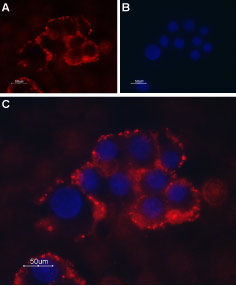Overview
- Peptide (C)SMGQMLQDFGK, corresponding to amino acid residues 495-505 of rat TRPC1 (Accession Q9QX01). 2nd extracellular loop.

 Western blot analysis of rat brain lysate:1. Anti-TRPC1 (extracellular) Antibody (#ACC-118), (1:200).
Western blot analysis of rat brain lysate:1. Anti-TRPC1 (extracellular) Antibody (#ACC-118), (1:200).
2. Anti-TRPC1 (extracellular) Antibody, preincubated with TRPC1 (extracellular) Blocking Peptide (#BLP-CC118).
 Expression of TRPC1 in PC12 cellsCell surface detection of TRPC1 in intact living PC12 cells. A. Extracellular staining of cells with Anti-TRPC1 (extracellular) Antibody (#ACC-118), (1:50) followed by goat anti-rabbit-AlexaFluor-594 secondary antibody. B. Nuclear staining with DAPI as the counterstain. C. Merged images of A and B.
Expression of TRPC1 in PC12 cellsCell surface detection of TRPC1 in intact living PC12 cells. A. Extracellular staining of cells with Anti-TRPC1 (extracellular) Antibody (#ACC-118), (1:50) followed by goat anti-rabbit-AlexaFluor-594 secondary antibody. B. Nuclear staining with DAPI as the counterstain. C. Merged images of A and B.
- Moran, M.M. et al. (2004) Current Opin. Neurobiol. 14, 362.
- Clapham, D.E. et al. (2003) Pharmacol. Rev. 55, 591.
- Clapham, D.E. (2003) Nature 426, 517.
- Padinjat, R. and Andrews, S. (2004) J. Cell. Sci. 117, 5707.
- Huang, C.L. (2004) J. Am. Soc. Nephrol. 15, 1690.
- Liu, X. et al. (2003) J. Biol. Chem. 278, 11337.
The Transient Receptor Potential (TRP) superfamily is one of the largest ion channel families and consists of diverse groups of proteins. In mammals, about 28 genes encode the TRP ion channel subunits. The mammalian TRP superfamily comprises six subfamilies known as the TRPC (canonical), TRPV (vanilloid), TRPM (melastatin), TRPML (mucolipins), TRPP (polycystin) and the TRPA (ANKTM1) ion channels1-4.
The TRPC subfamily consists of seven proteins named TRPC1 to 7, which can be further divided into four subgroups based on their sequence homology and functional similarities:
1.) TRPC1 2.) TRPC4 and TRPC5 3.) TRPC3, TRPC6, TRPC7 4.) TRPC22,5. They are highly expressed in the central nervous system and to a lesser extent in peripheral tissues.
TRPC1 was the first mammalian TRP protein that was reported to form an ion channel2. It can co-assemble with other TRPC subunits (TRPC3, TRPC4, TRPC5) to form heterotetramers whose properties are distinct from that of their homomeric form. The existence of the TRPC1 homomers has not been established as yet1-3.
The TRPC1, TRPC4 and TRPC5 can be activated either by Ca2+, store depletion or by GPCR stimulation pathways, while TRPC3, TRPC6 and TRPC7 form non-selective cationic channels that are activated by the stimulation of GPCRs. TRPC1, 4 and TRPC5 are assumed to form components of store operated channels in some cell types such as salivary gland cells, endothelial cells and vascular smooth muscle cells6.
Application key:
Species reactivity key:
Anti-TRPC1 (extracellular) Antibody (#ACC-118) is a highly specific antibody directed against an epitope of the rat protein. The antibody can be used in western blot, live cell imaging, and immunocytochemistry and indirect flow cytometry applications. It has been designed to recognize TRPC1 from mouse, rat, and human samples.
Applications
Citations
- Live intact mouse oligodendrocyte progenitor cells (1:100).
Paez, P.M. et al. (2011) J. Neurosci. 31, 3625.
- Ng, L.C. et al. (2012) Am. J. Physiol. 303, C1156.

